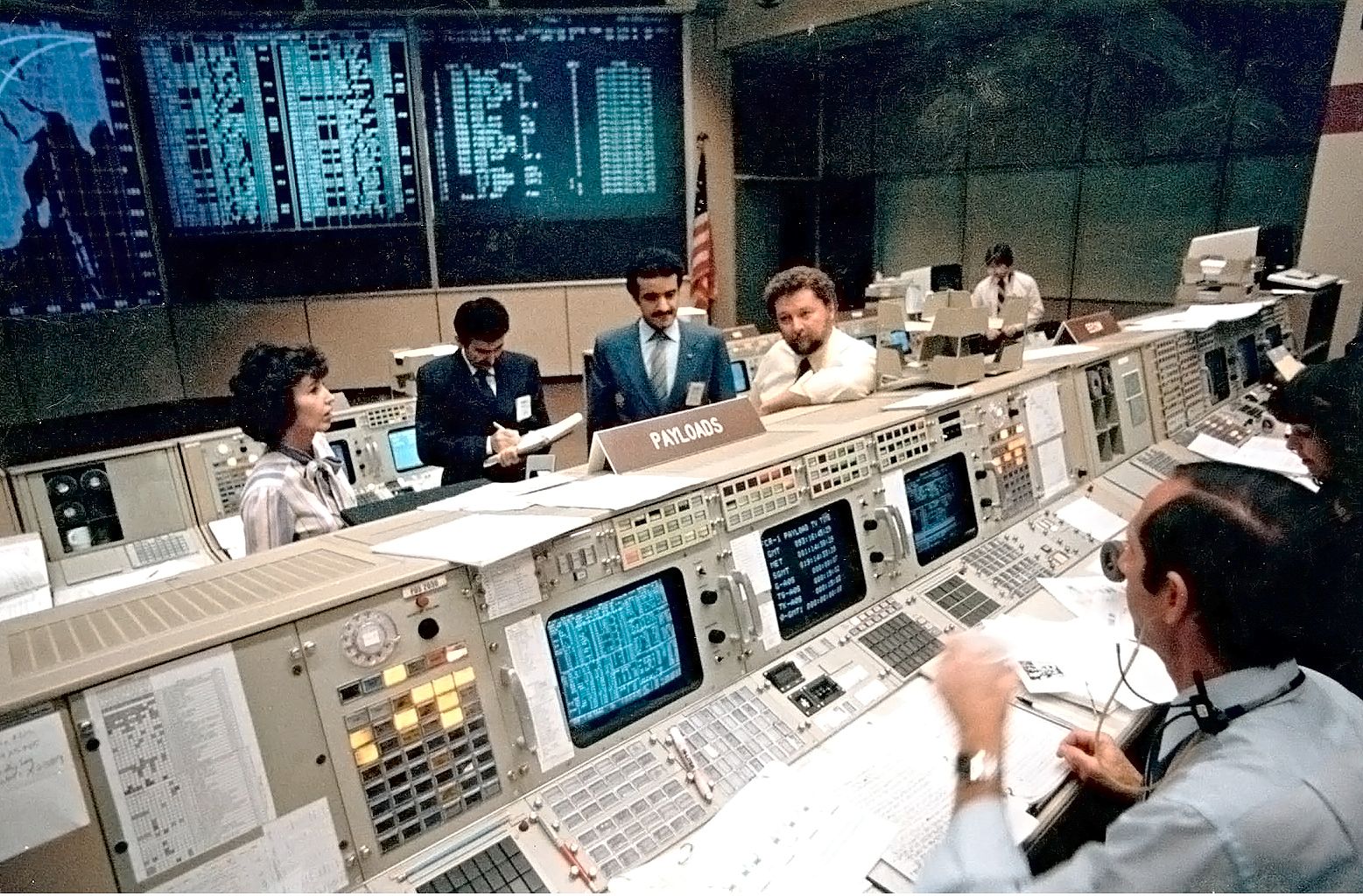When a Saudi
went to space
As the world celebrates the 50th anniversary of the moon landing, Prince Sultan bin Salman, son of the king, talks exclusively to Arab News about how he became the first Arab, Muslim – and royal – in space
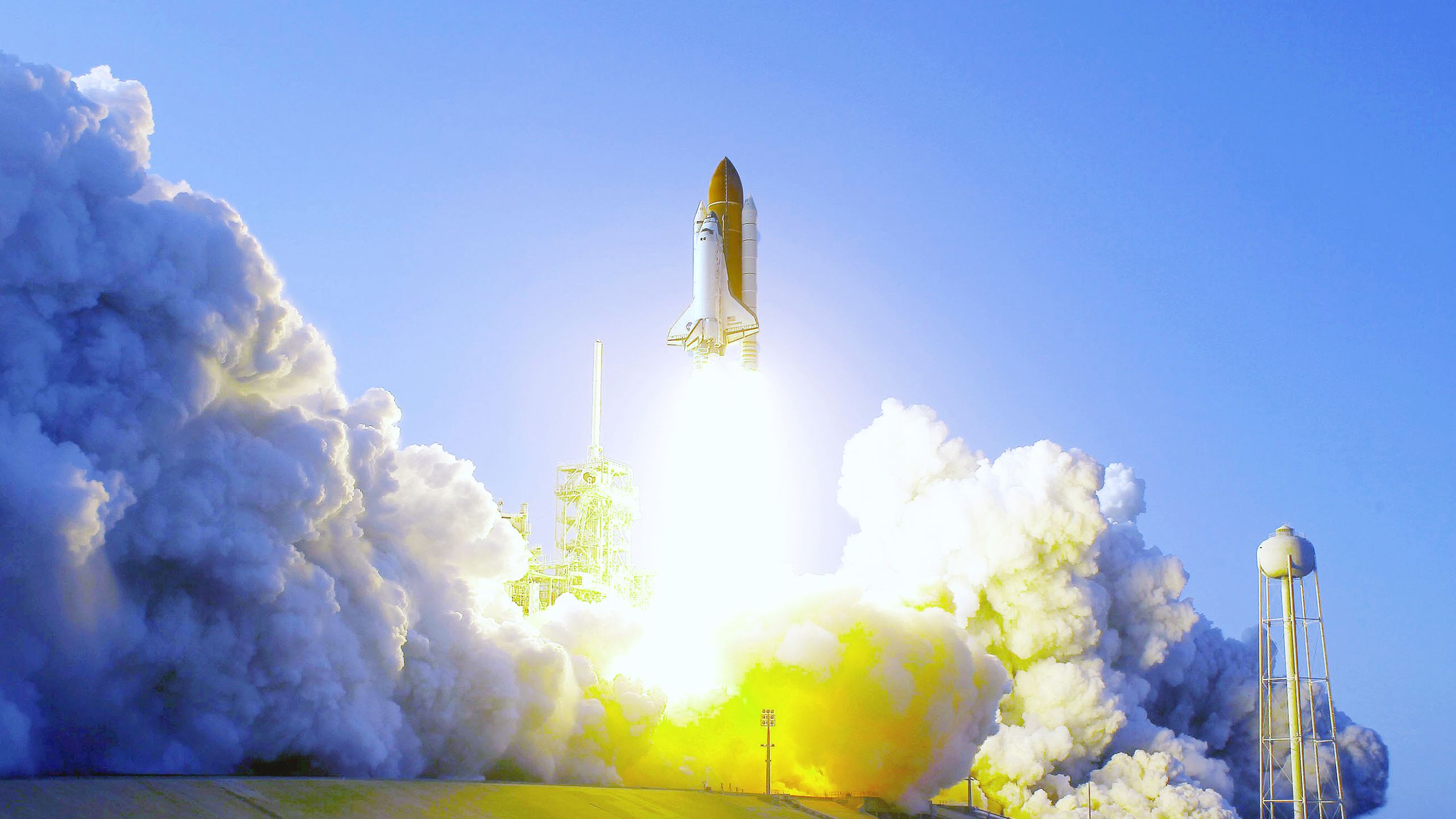
Fifty years ago, on July 20, 1969, one not-so-small event changed how we see the world. Two American astronauts, Neil Armstrong and Buzz Aldrin, did what was once thought impossible: They took man’s first steps on the moon. Armstrong famously said: “That’s one small step for man, one giant leap for mankind.” True to his words, advancement in space has skyrocketed since the Apollo 11 mission, opening up doors for space scientists to reach for the stars.
It was only 16 years later that the first Arab, Muslim — and royal — astronaut traveled into space, and he will be in Houston for the Apollo mission anniversary. As the second son of Saudi Arabia’s King Salman, he needs little introduction. Prince Sultan bin Salman Al-Saud, the recently appointed chairman of the Saudi Space Commission, was aboard Discovery when it launched into space on NASA Mission STS-51G on June 17, 1985.
As the world reflects on one of mankind’s most dramatic achievements, Prince Sultan, who recently released his book “7 Days in Space,” sat down with Arab News for a special one-on-one interview to talk about his own remarkable journey, the first small step for the future of Saudis in space.
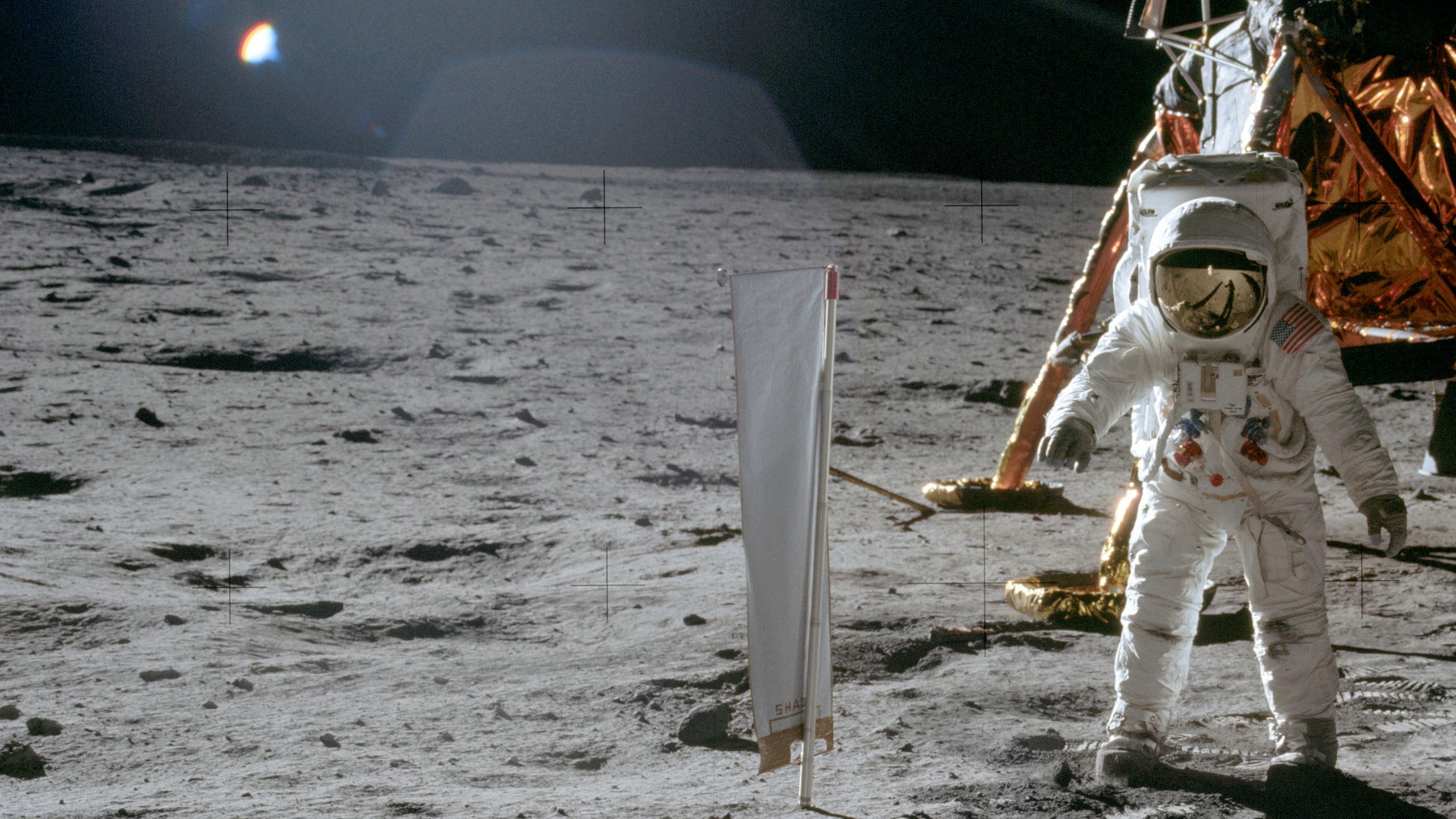
First steps
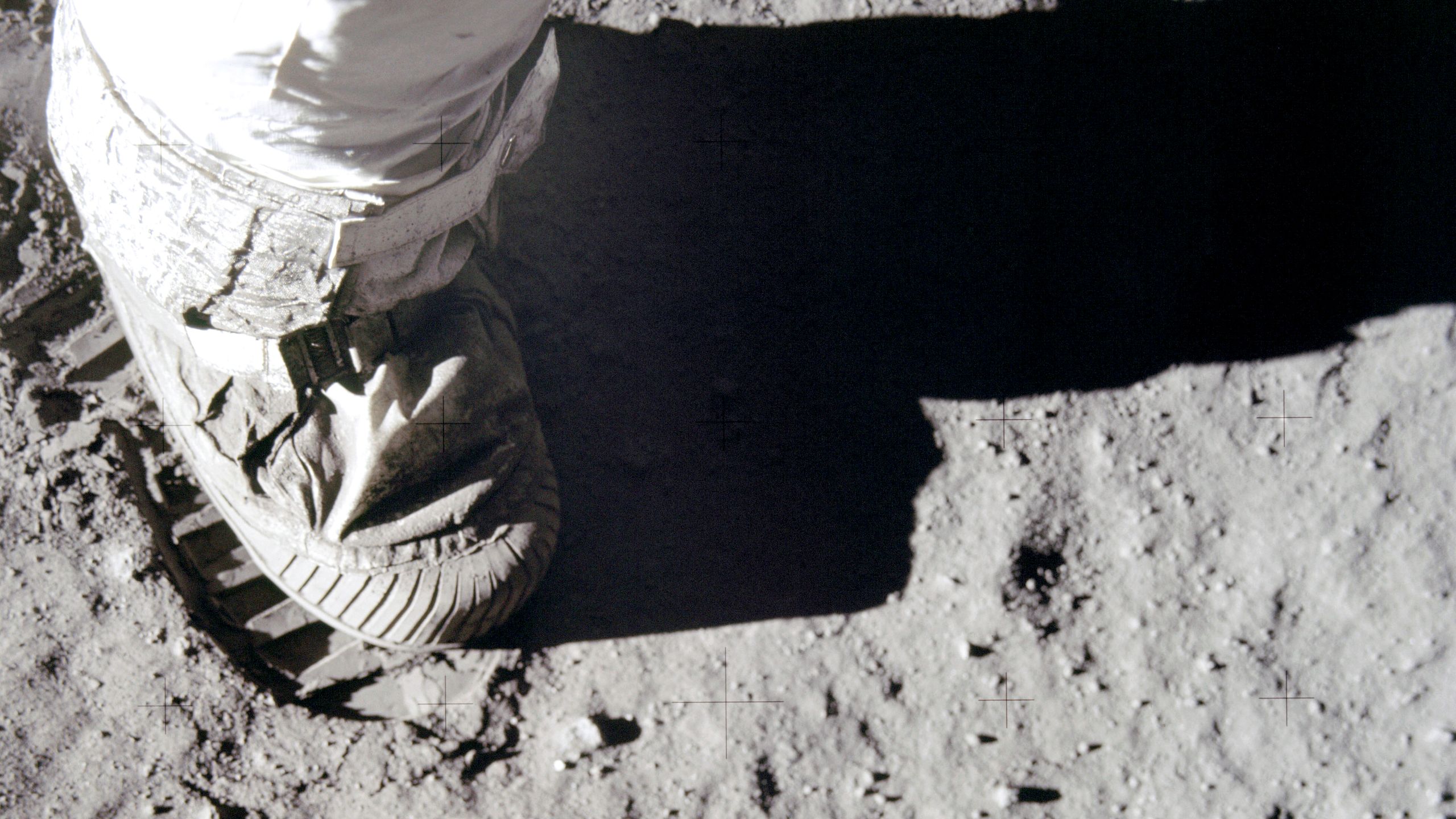
In an exclusive interview, Prince Sultan shares his recollections of watching the moon landing on TV in Saudi Arabia on July 20, 1969.
In an exclusive interview, Prince Sultan shares his recollections of watching the moon landing on TV in Saudi Arabia.
How the moon landing inspired a young prince
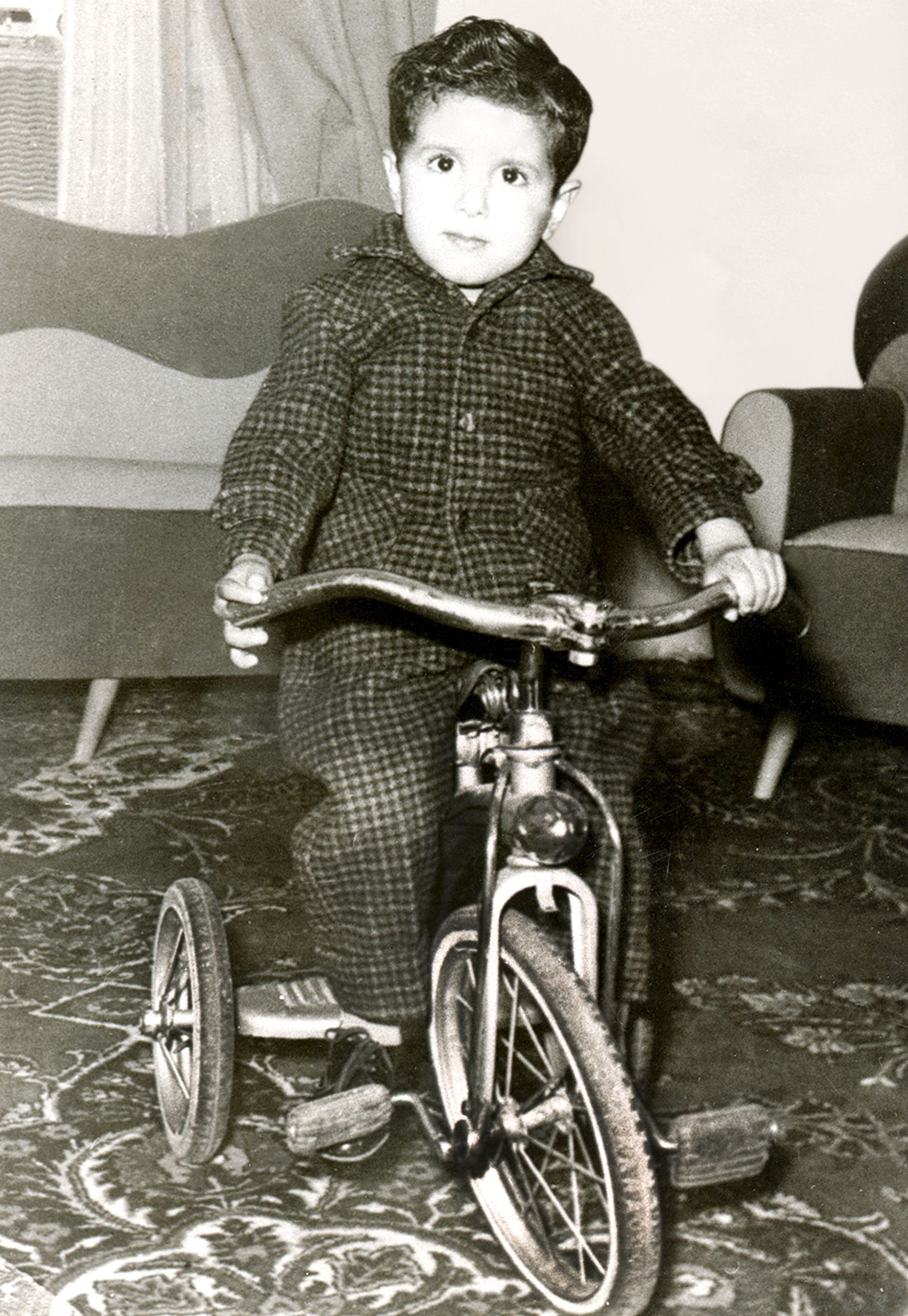
Prince Sultan as a child.
In Saudi Arabia’s capital Riyadh, a 13-year-old boy first heard of the historic moon landing via radio. After discussing the Apollo 11 mission at his school, the Model Capital Institute, Prince Sultan could barely wait to get back home to the palace to watch it on television. The picture quality might have been poor and the sound garbled, but footage of the landing captured his imagination.
“Humans made airplanes and made advances in industry, but for humans to leave their own planet, that’s really something else,” Prince Sultan said, sitting in his office in Riyadh.
As a young boy, the prince saw Saudi military students in Riyadh strut proudly in their uniforms and envisioned himself alongside them. However, his dreams were put on hold when he was diagnosed with rheumatism in junior high. The illness kept him away from school for a year and made strenuous physical activity impossible for several years.
Traveling to the US to continue his studies in mass communications at the University of Denver in 1974 (he later obtained a master's in social science from Syracuse University in 1999), Prince Sultan was determined to realize his dream of flying. He took aviation lessons during his free time and gained his private pilot license in 1977 from the US Federal Aviation Administration.
At the time, space flight was not on his agenda, the prince revealed, after he “dismissed as impossible the idea that somebody from the Arab world” would venture into space. However, following the Kingdom’s key role in the Arab League’s formation of Arabsat, a satellite communications company, in 1976, the impossible began to seem possible.
Arabsat launched its first satellite, Arabsat-1A, on a French rocket in February 1985. With its second satellite, Arabsat-1B, ready to be launched the same year by the National Aeronautics and Space Administration (NASA), the Arab League’s member countries were permitted to select a payload specialist to travel aboard the space shuttle Discovery. Saudi Arabia won the slot.
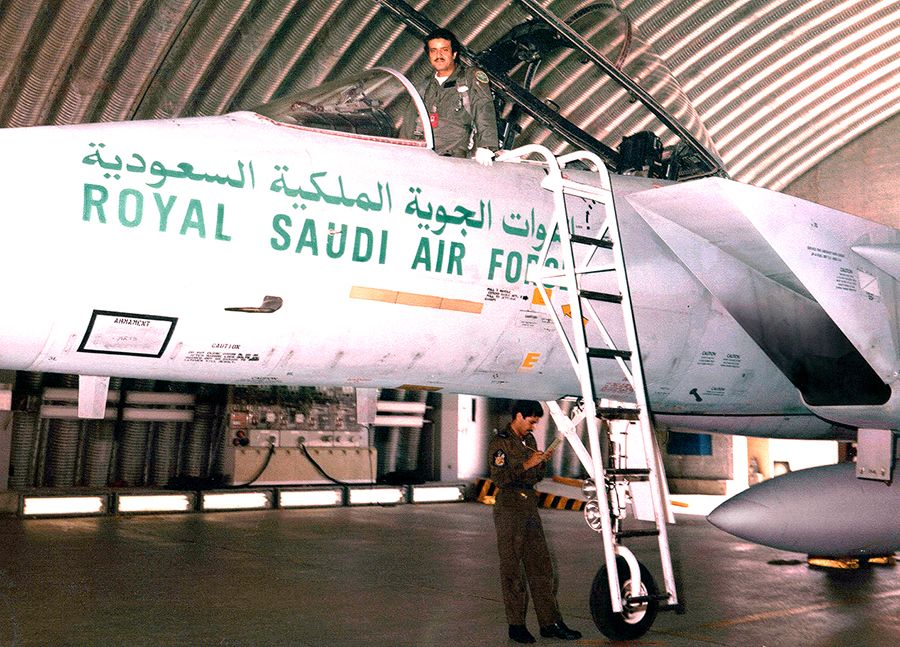
Before the Saudi Air Force, Prince Sultan earned his private pilot license.
Before the Saudi Air Force, Prince Sultan earned his private pilot license.
The search for the best candidate took months. Lacking the usual 12-month time frame for training, the selection was restricted to qualified pilots who spoke fluent English and were physically prepared for the rigors of space travel. After clocking 1,000 flying hours and passing intensive medical examinations in Riyadh and the US, Prince Sultan was an obvious choice. He asked his parents for permission to submit his name as one of the candidates and received their blessing.
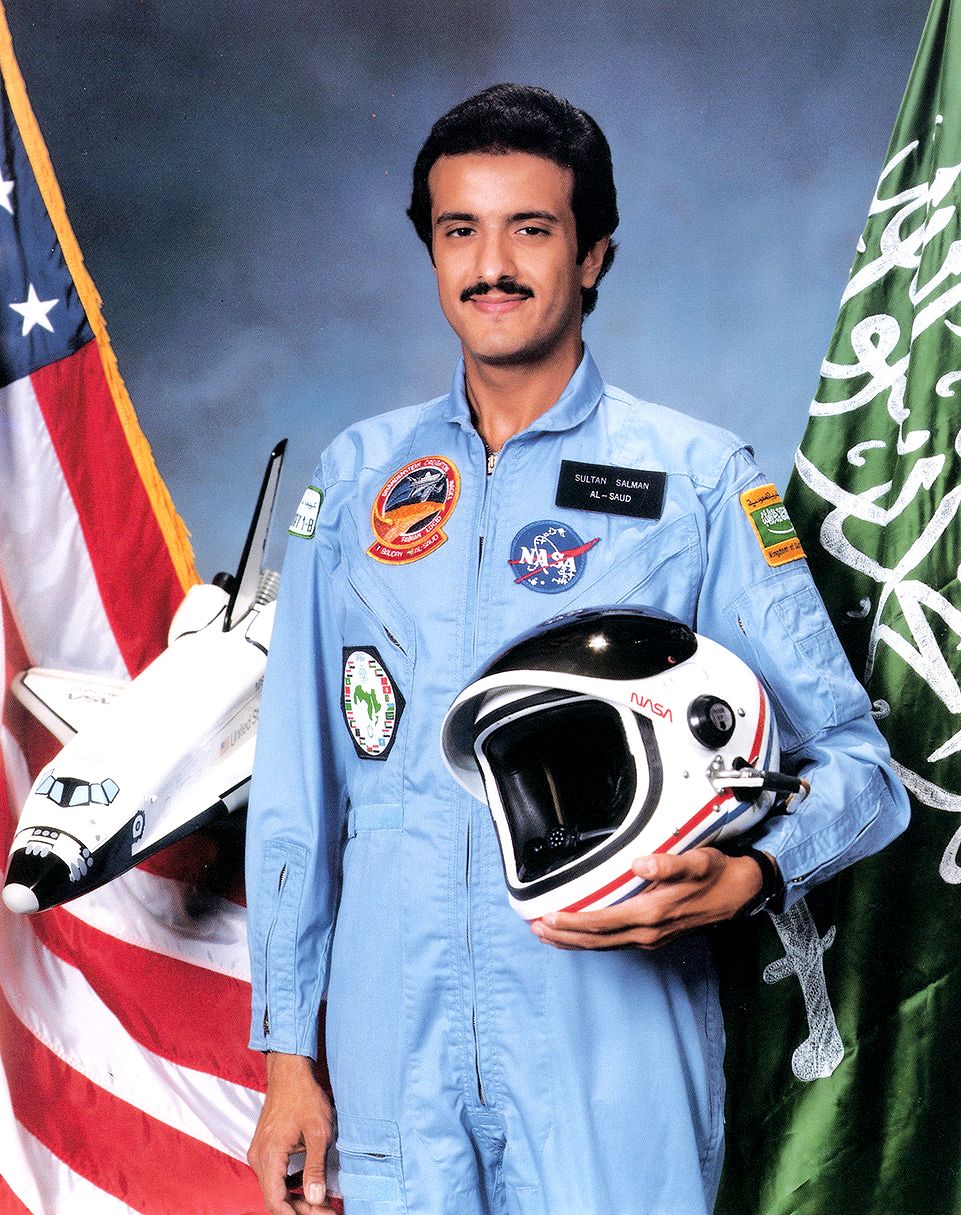
Prince Sultan's official NASA portrait.
NASA accepted two candidates — the primary payload specialist and a backup who would be trained to take over if the primary astronaut was forced to drop out of the mission. Prince Sultan was named the primary payload specialist. At 28, he would be the youngest astronaut on the crew. Maj. Abdulmohsen Hamad Al-Bassam, a 36-year-old instructor in the Royal Saudi Air Force, was selected as his backup.
When he was chosen for the mission, Prince Sultan was working as an official at the Saudi Ministry of Information. “I only transitioned to become a part of the Ministry of Defense, the Saudi Air Force, when we came back,” he said.

Prince Sultan as a child.
Prince Sultan as a child.

Prince Sultan's official NASA portrait showing his mission patch.
Prince Sultan's official NASA portrait.
Training
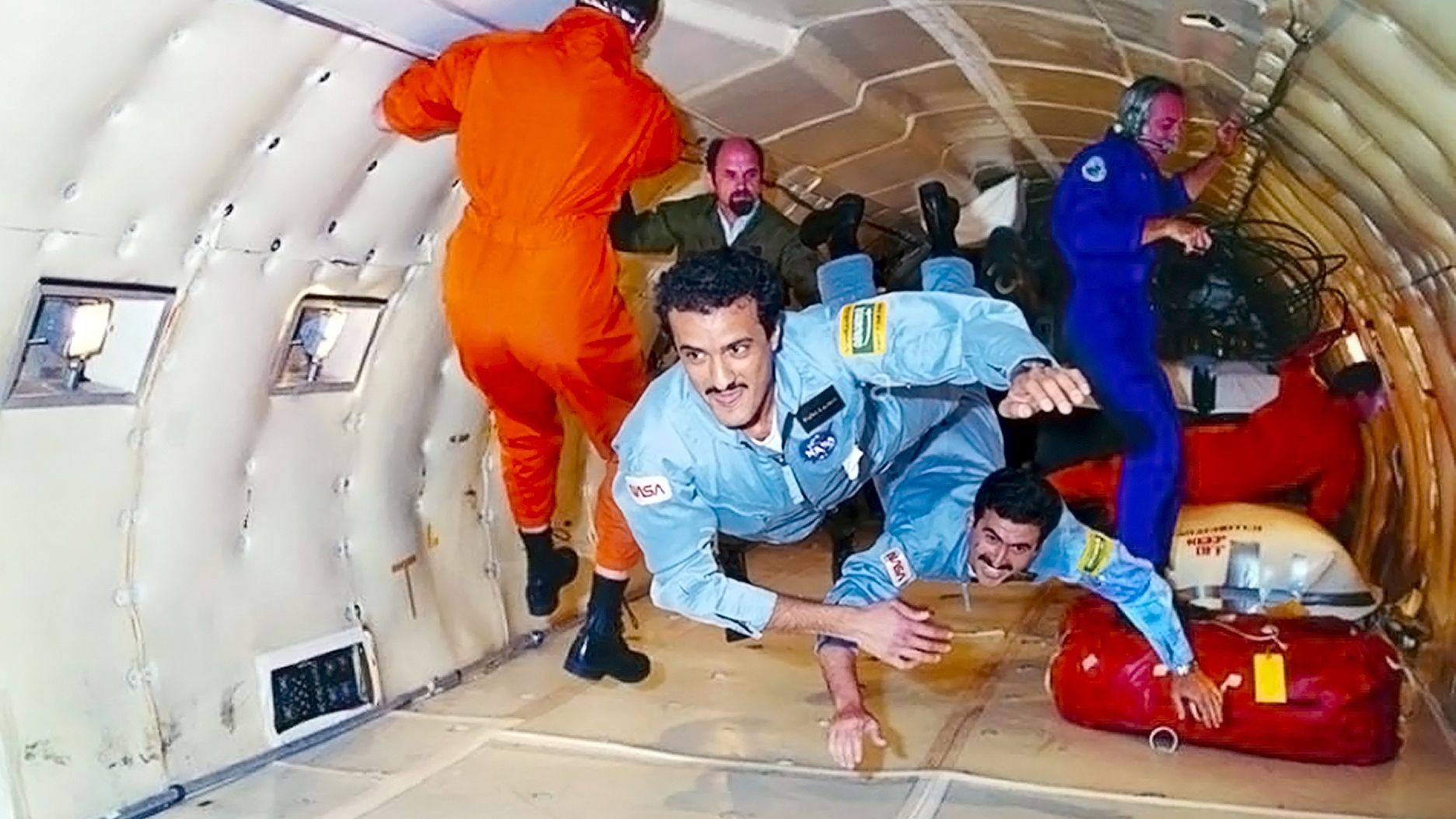
Prince Sultan speaks about what was on his mind while training for his NASA mission in June 1985.
Prince Sultan speaks about what was on his mind while training for his NASA mission.
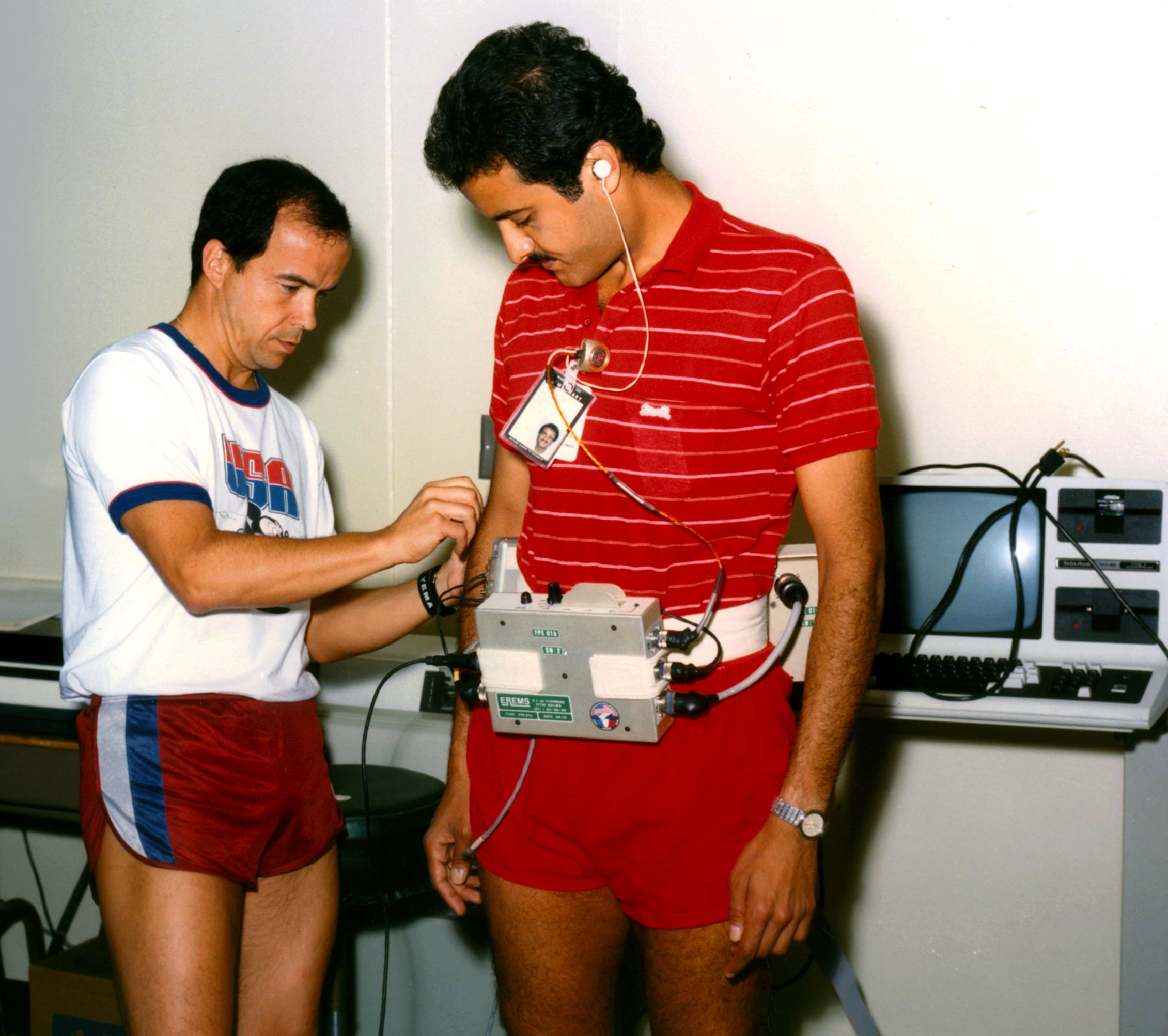
Prince Sultan and Patrick Baudry preparing for a posture experiment.
Prince Sultan and Patrick Baudry in training.
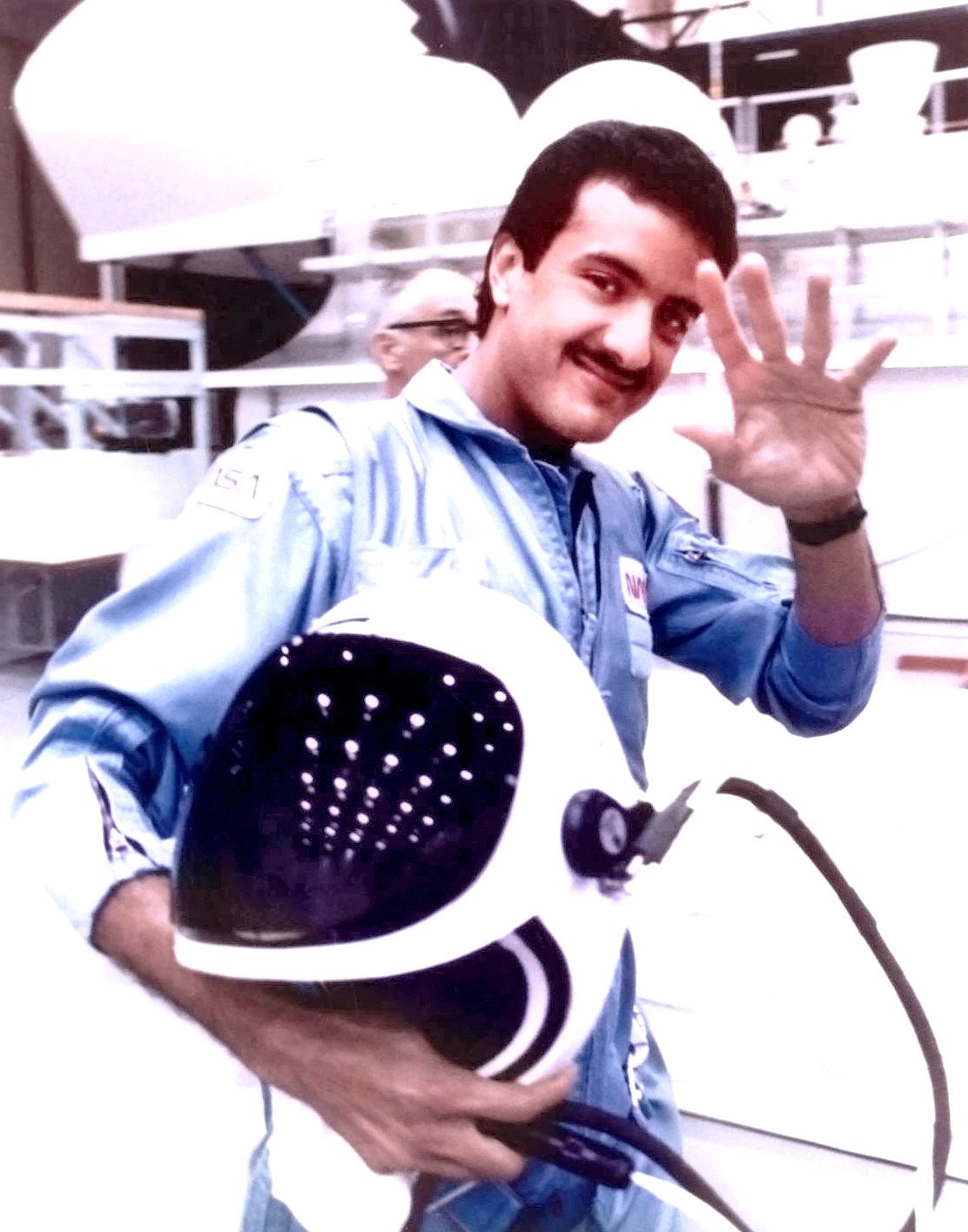
With his space helmet at the Johnson Space Center in Houston.
At the Johnson Space Center in Houston.
Preparing for space, fasting for Ramadan

Prince Sultan and Patrick Baudry in training.
In order to take part in the space mission, Prince Sultan and his backup, Al-Bassam, had to undergo demanding physical preparation that consisted of 114 hours of what NASA calls “habitability” training, learning to adapt to the daily routines of life in a space shuttle.
It takes anywhere between six to 18 months of intensive training to go into space, but the mission was moved up, so the pair had only 10 weeks to learn all the scientific and technical information, as well the exercises for the task of payload specialist. At times the training would last 16 hours a day, even during Ramadan when they were fasting.
“When we started the training and started the mission, you know, it became evident that we had a lot of work to do, especially since our mission was scheduled for the winter and then pulled back to the summer,” Prince Sultan recalled. “So, time was compressed. We were asked whether we were ready to work double shifts.”
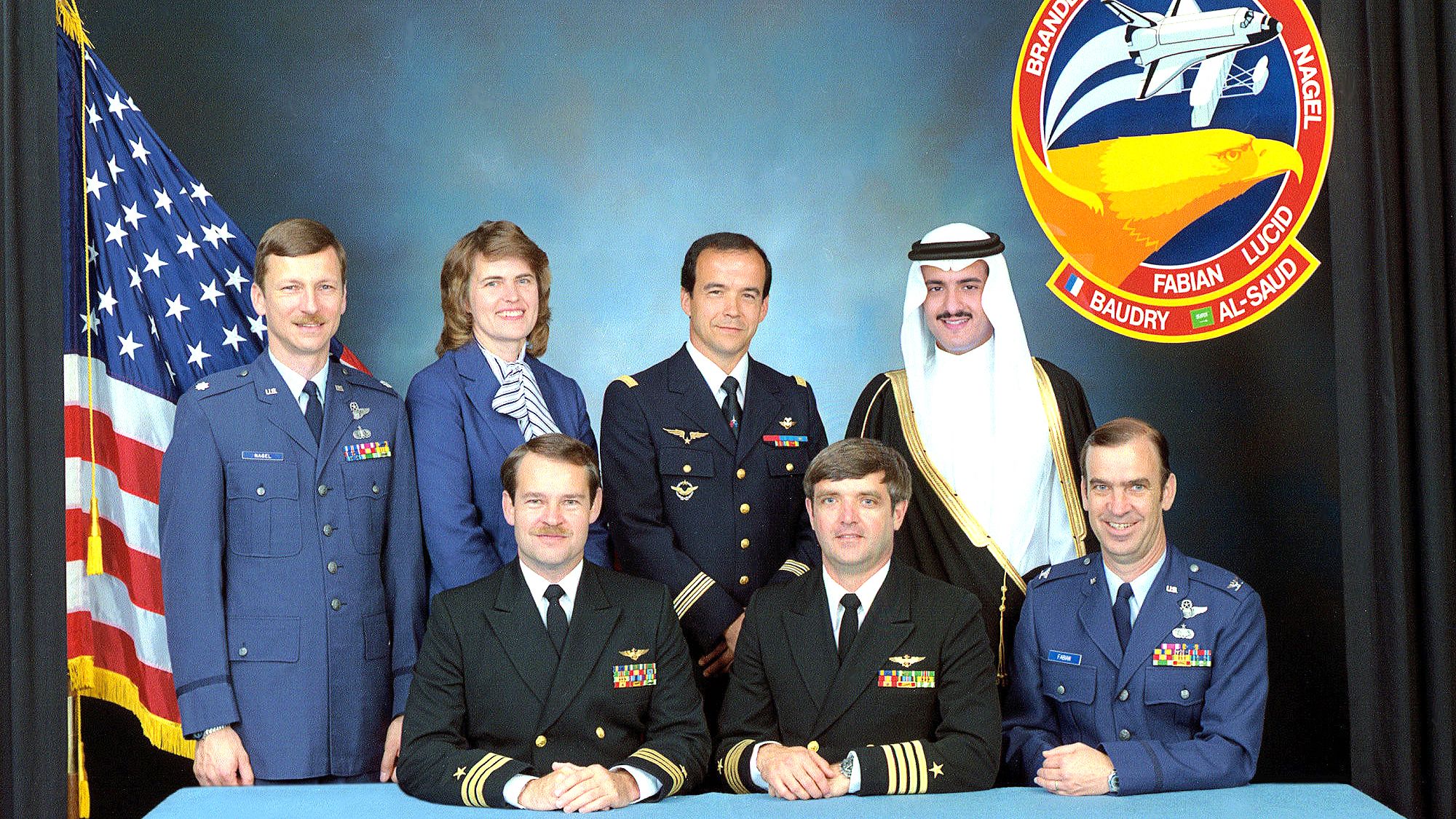
The crew, clockwise from Prince Sultan: John Fabian, Daniel Brandenstein, John Creighton, Steven Nagel, Shannon Lucid and Patrick Baudry.
The STS -51G crew photo.
The prince was undaunted and did not fear the challenges ahead. “Brave people are people who feel fear but still go forward,” he said.
However, one fear did resonate with him: “I was actually fearful of not flying, that I would be sick or fall or break something and then, you know, we’ll be pulled out of the mission and maybe we’ll never get into another mission. That was my biggest fear.”
Two weeks of training were conducted in Saudi Arabia, and the rest at NASA bases in Florida and Houston. In April 1985, the two men joined the mission’s six other astronauts, five of whom were from the US: Mission commander Daniel Brandenstein and pilot John Creighton, along with three mission specialists, John Fabian, Steven Nagel and Shannon Lucid, a graduate of NASA’s first astronaut class to include women. With Prince Sultan and Patrick Baudry, a payload specialist from France, this crew was the shuttle program’s most international line-up. Brandenstein called on the human resources department in Aramco’s Houston office to give his crew an introduction to Saudi customs.
Prince Sultan speaks highly of his comrades, saying they worked in unison and “became like family.” During the Houston training, he would break the fast with Madinah Al-Munawara dates, and Fabian tried one with him. After that, they shared the dates together with everyone who came to the service office at the Johnson Space Center every day.

At the Johnson Space Center in Houston.
During training, each of the astronauts chose their three daily meals with snacks that they would have in space; some would be fresh, while others would be dehydrated. Prince Sultan would be fasting for a day in space for Ramadan, but otherwise his meals consisted of Chinese sweet and sour chicken, steamed sweet corn, cauliflower with cheese, tuna, shrimp, salmon, meat, pasta, fruit salad, orange and pineapple juice, tea and decaffeinated coffee.
While the astronauts were in training, Discovery was being readied for its flight by a team working in the Kennedy Space Center’s Vehicle Assembly Building.
Discovery, named after the ships used by explorers Henry Hudson and James Cook, was the third space shuttle orbiter to join the fleet since NASA launched its first, Columbia, in 1981. With nine missions that year, 1985 was NASA’s busiest yet; the program was curtailed after the Challenger, NASA’s second space shuttle, broke apart on liftoff in 1986, only six months after Prince Sultan traveled into space. His mission, designated STS-51G, would be Discovery’s fifth journey into space.
A team of about 30 NASA engineers and technicians supervised the slow-motion “roll-out” on a crawler-transporter that inched the shuttle more than 5 km toward launch pad 39A, the same platform used for the Apollo 11 mission.
From there, any number of factors could have delayed the timing of the mission. The evening before Discovery’s launch, lightning struck the launch pad’s support structure, but fortunately did not cause a delay.
Following NASA tradition, the astronauts enjoyed a barbecue dinner at a private beach house on Cape Canaveral’s Neptune Beach, from where it was possible to see their home in space illuminated by bright searchlights in the Florida sky.
Liftoff
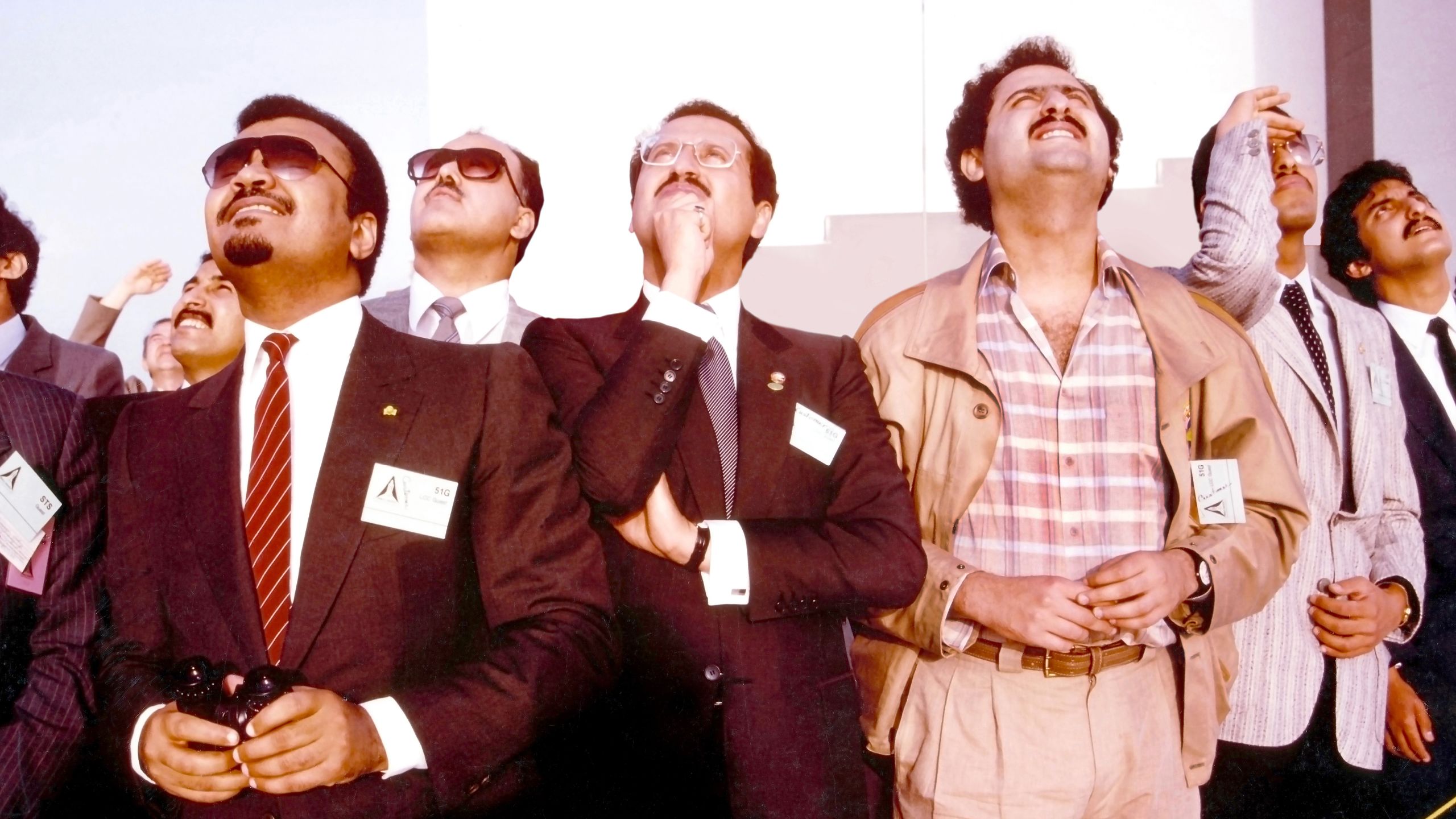
Prince Sultan describes what it's like to lift off with 2.5 million pounds of thrust – and then to enter zero gravity in space.
Prince Sultan describes what it's like to lift off with 2.5 million pounds of thrust.
Watch NASA footage of Prince Sultan suiting up for the launch.
'It’s nothing like anything you've seen'
Launch day finally arrived on June 17, 1985. The astronauts woke at 2 a.m. to get suited up for their journey into space, performing a ceremonial walkout to their bus ride to Launch Pad 39A. At 7.33 a.m. the Discovery’s three main engines started up, and the rocket boosters ignited with a deafening roar, the ground beneath rumbling ferociously.
STS-51G had a perfect liftoff, the spacecraft soaring into orbit through a near-cloudless Florida sky, cheered and applauded by about 230 Arab guests of NASA. Among them were 29 Saudi princes, including four of Prince Sultan’s brothers — Prince Fahd, Prince Ahmed, Prince Abdul Aziz and Prince Faisal — along with Prince Bandar bin Sultan, the Saudi ambassador to the US; Dr. Ali Al-Mashat, director-general of Arabsat; and Gene Roddenberry, creator of the science-fiction series “Star Trek.”
Prince Sultan’s backup was also watching from the ground. “This is one of the greatest moments,” Al-Bassam said. “He (Prince Sultan) is the first Muslim to travel into space.”
While the cheering continued outside, inside the space shuttle the astronauts confronted a very different situation. When a space shuttle takes off, the rocket boosters deliver enough thrust to escape the force of gravity before separating about two minutes after launch. Hence the G-force, or what fighter pilots refer to as “pulling Gs” — a pressure that is greater and lasts longer for astronauts, equivalent to three times the force of gravity humans are normally exposed to on Earth.
'And we have a go:' Watch Discovery's countdown and liftoff.
Amid the rockets’ deafening noise, the extreme G-force hit every inch of the astronauts’ bodies, pressing on their lungs and forcing them to breathe in small gasps. The boosters separated in a bright flash, engulfing the shuttle’s front windows in flame for half a second.
It was an experience they had trained for, but Prince Sultan said: “When those rocket boosters ignite, there is no switch to turn them off. It’s solid, dark fuel. It’s just going to burn. So, you’re in it. And when the space shuttle starts flying and then starts turning, you know, this is amazing because then you start ‘pulling the Gs’ on the stomach, so you literally can’t breathe. You try to gasp for breath, and it goes on, not like flying a fighter. It goes on for over a minute, just pressure on the body.”
Doubts can creep in when the pressure and noise assault the senses. “That’s when you start thinking, wait a minute, you know, maybe this is it,” Prince Sultan said. “You’re going to die of suffocation, but you don’t. The training allows you to react, to try to push the breathing.”
After the quietness of space settles in, strange things start to happen in zero gravity, when everything becomes weightless. “These things start coming off. The rocket boosters come out, and it becomes much more quiet. When you get into space, what hits you first is little things floating, little nails, little things that started flying around from the shaking.”
The moment the astronauts were safely in space, the colossal experience began to sink in. “It’s nothing like anything you’ve seen,” the prince recalled. “What hits you is the blackness. People say space is black, but it’s really the light shifting. It makes you see it as that color. And it’s in the middle of nowhere.
“And you are alone. We were totally alone there. And it’s a small world. These visuals go with you through your lifetime.”
The mission
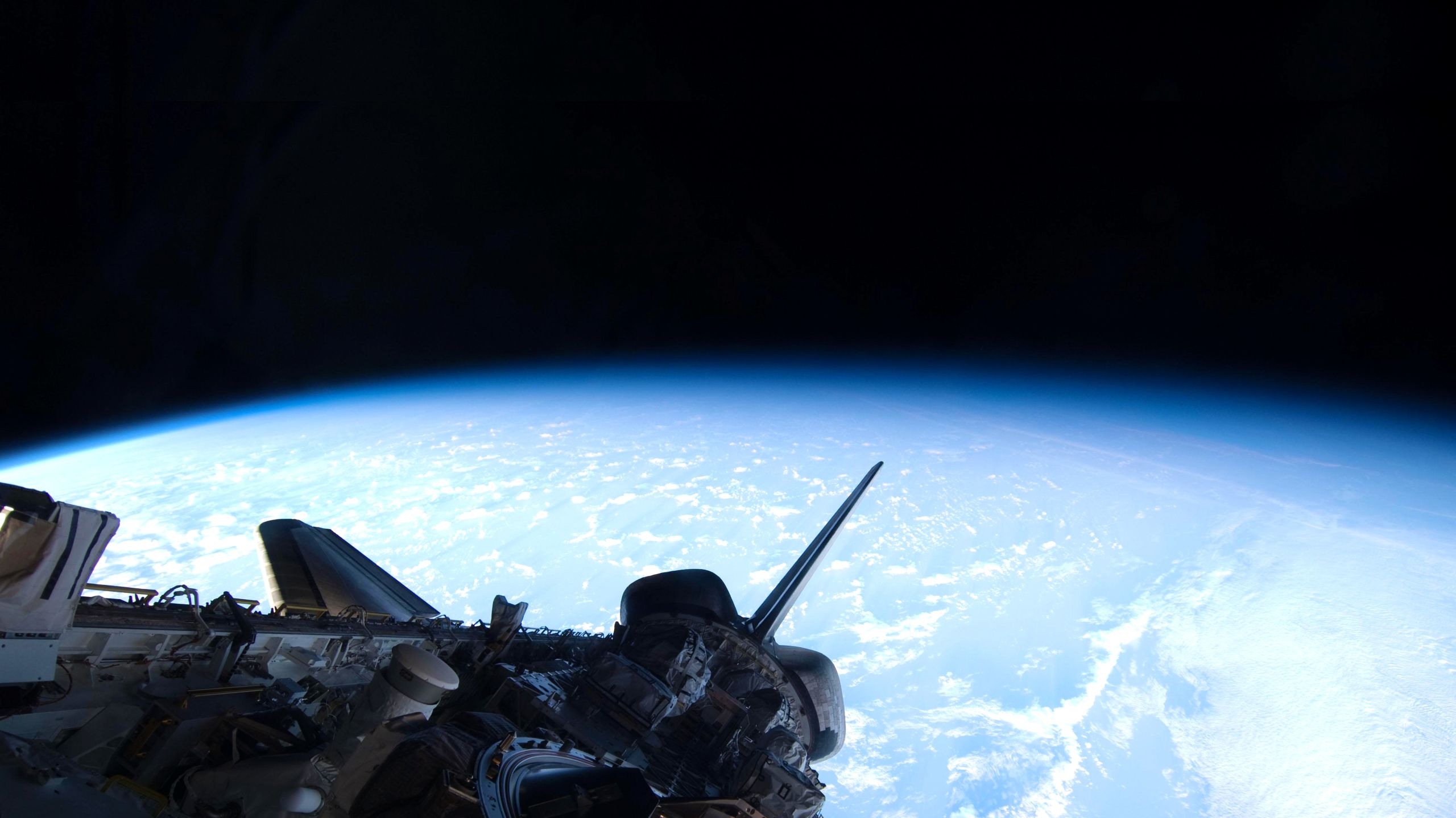
Prince Sultan describes what it's like being in space and how it widens your perspective on life: 'It takes you to the next dimension.'
Prince Sultan describes being in space.
Reading the Qur'an in space
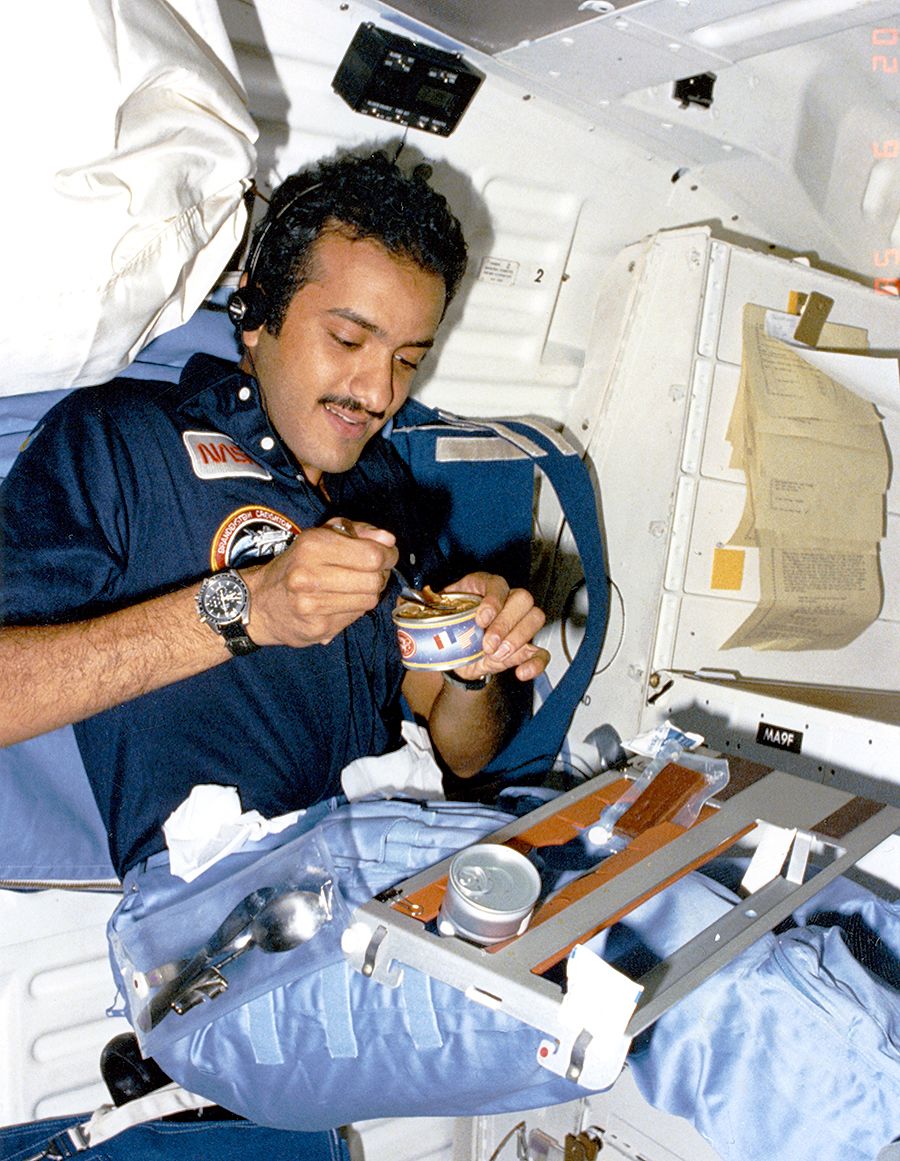
A tuna break in space.
Once the drama of the liftoff had passed, it was time for the astronauts’ real work to begin, with seven days to conduct their experiments and deploy their equipment while they circled the Earth 111 times.
Eight hours after liftoff, the crew deployed Morelos-A, Mexico’s first communications satellite, which would provide TV programs to remote areas of the country. As a payload specialist, Prince Sultan’s main task was to oversee the deployment of Arabsat-1B, which was performed successfully from the Discovery’s cargo bay on June 18; Telstar-3D for AT&T in the US followed the next day.
On June 20, the crew used the shuttle’s mechanical arm to deploy the Shuttle Pointed Autonomous Research Tool for Astronomy, a 1,000-kg box with instruments to map X-ray emissions in the universe, including the Milky Way. It was retrieved two days after observations.
Another experiment involved the Strategic Defense Initiative of then-US president Ronald Reagan, a proposed space-based missile defense system involving lasers dubbed “Star Wars.” Discovery carried a target that would be tracked by a laser beam projected from a test site in Hawaii, testing the capability to track a moving object in space.
Prince Sultan conducted other scientific experiments aboard the shuttle, including one that measured ionized gas in rocket exhaust, in conjunction with King Fahd University of Petroleum and Minerals. In another, the prince took photos of southwestern Saudi Arabia, which were used to help develop a groundwater exploration program and research into sand movement in the Kingdom.
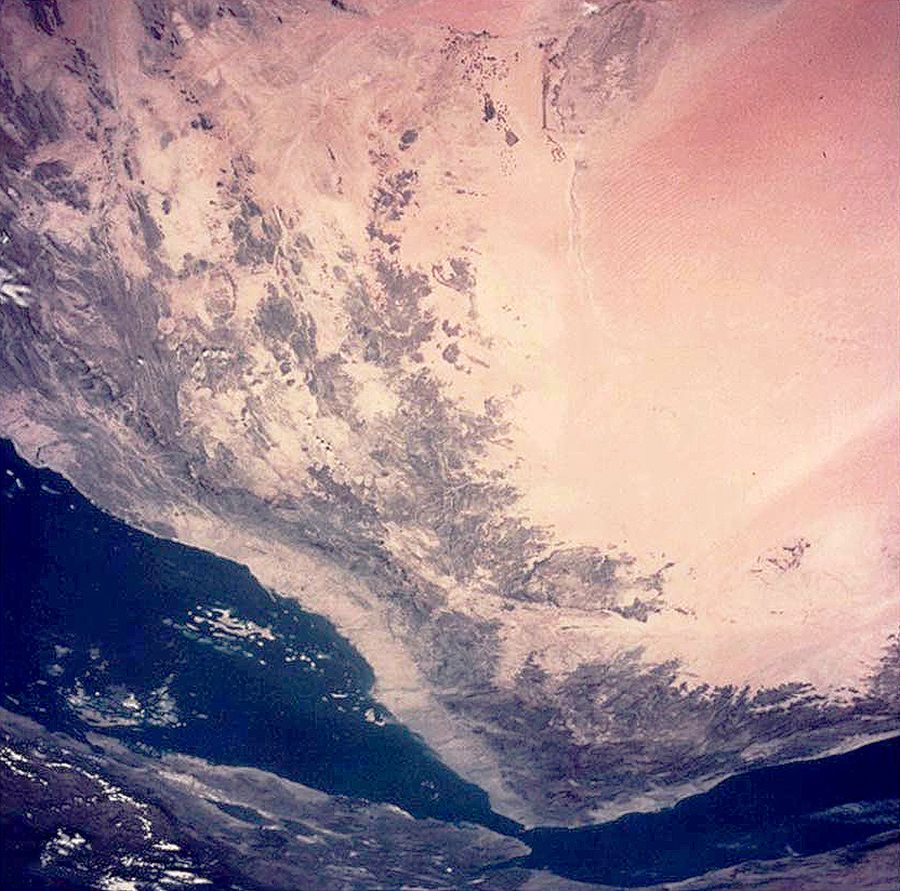
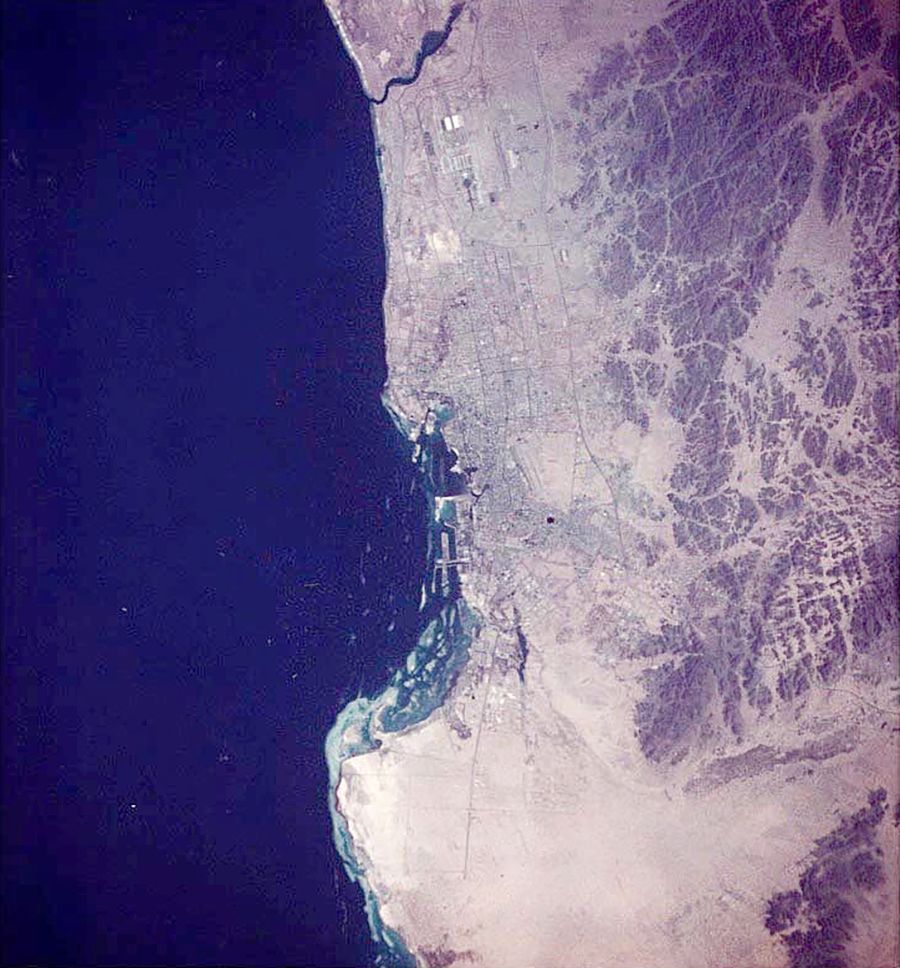
Prince Sultan's photos of southwestern Saudi Arabia, including Jeddah, above, taken from space with a Hasselblad camera.
Prince Sultan's photos of southwestern Saudi Arabia, including Jeddah, above.
Observing Earth from space was more than just a scientific experiment. It helped Prince Sultan realize that we are all connected. “The first day or so we all pointed to our countries. The third or fourth day we were pointing to our continents. By the fifth day, we were aware of only one Earth,” he said.
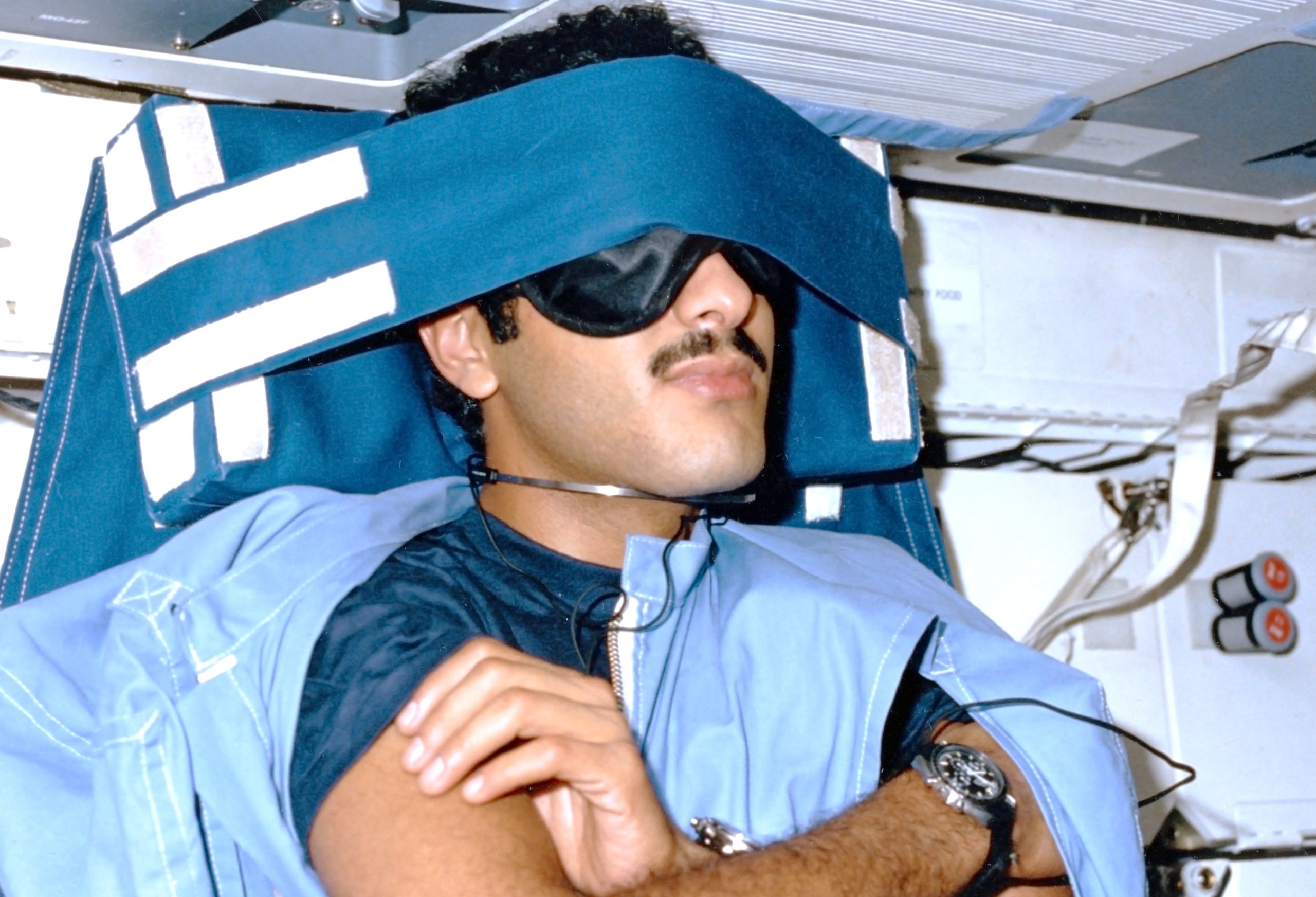
With the sun rising 16 times a day in space, the astronauts used eye masks to sleep.
The astronauts had eight hours reserved for sleep before being woken by mission control with daily music. On the sixth day, as a nod to Prince Sultan, they played a song, “Abaad Kontom Wala Garayebein” (“Near or Far“), by the Saudi singer Mohammed Abdo.
Hear the Mohammed Abdo song that mission control played in space for Prince Sultan's wake-up call.
Since Prince Sultan sleeps as little as five to six hours each day, he decided to use the spare time wisely, by reading the Qur’an in space. “I’m not saying I finished it and I read very slowly because I just wanted to have that honor,” he said. “You know, I was really doing it for my father and mother, not for myself.”
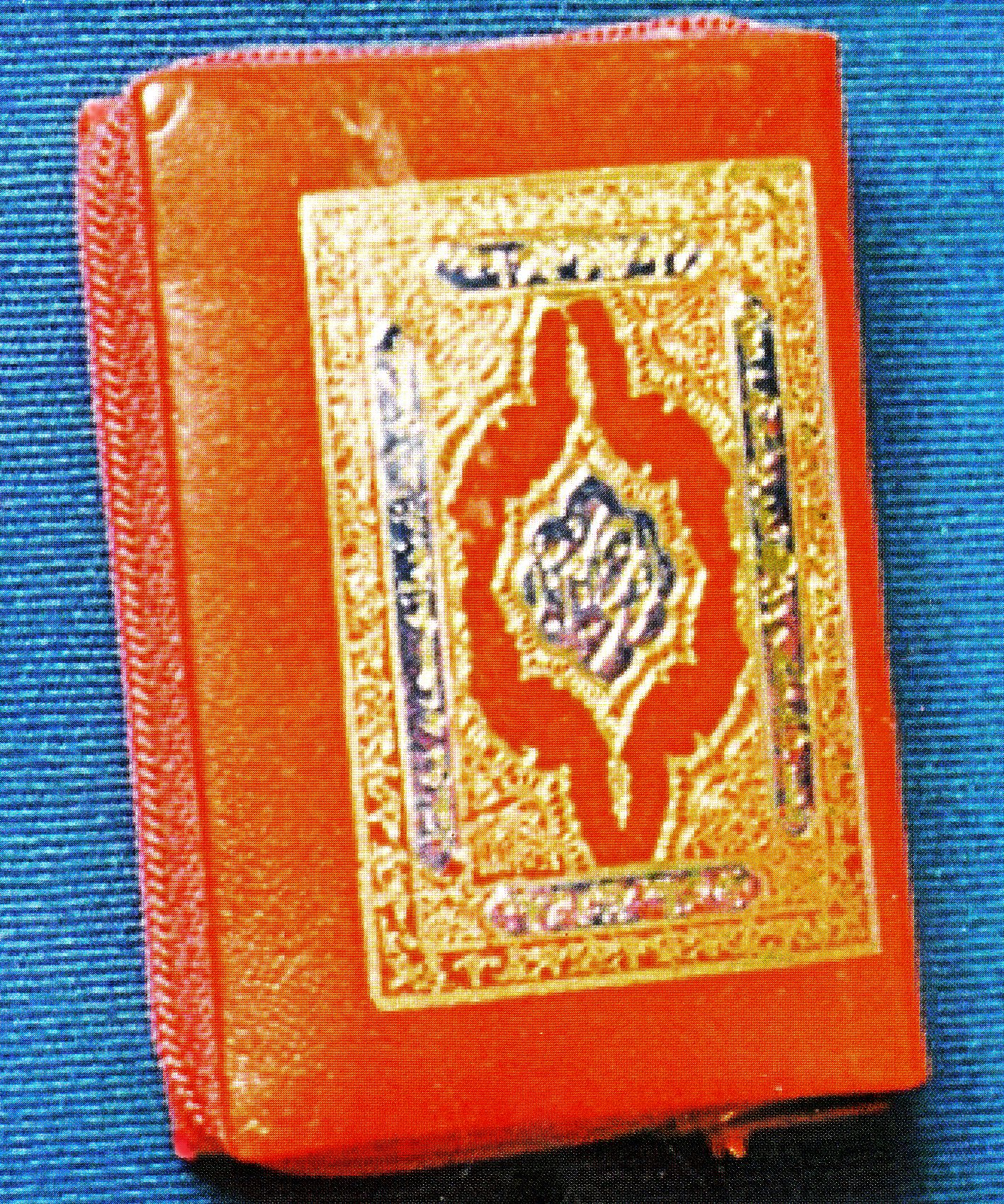
The Qur'an from his father that Prince Sultan read in space.
The Qur'an from his father that Prince Sultan read in space.
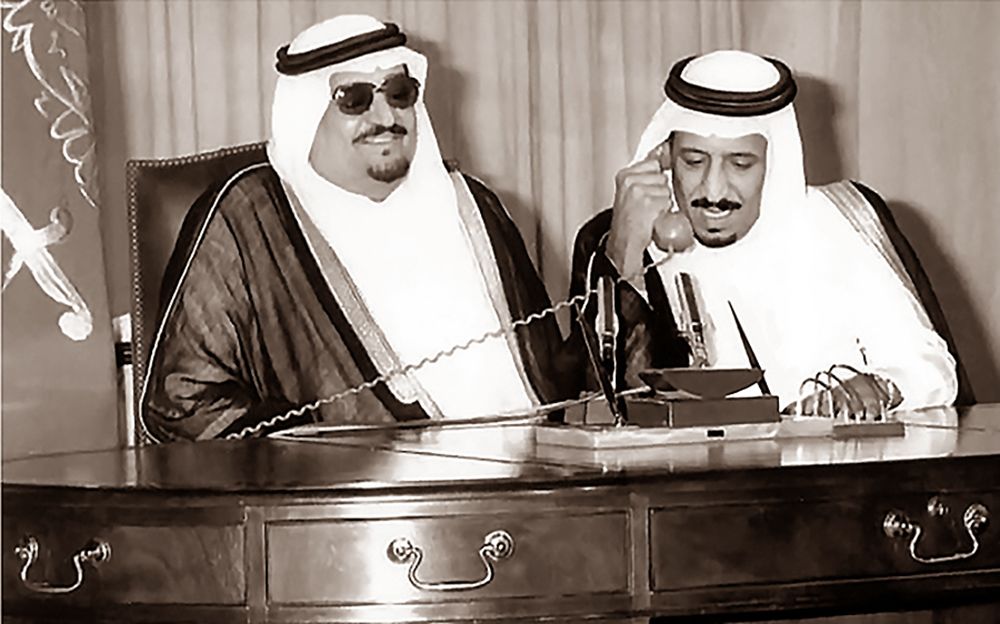
King Salman, with the late King Fahd, speaks to his son in space.
In a teleconference broadcast on “Arab Live,” in which King Fahd wished Prince Sultan a successful mission, his father, then governor of Riyadh, appeared alongside the king, and talked to him about the Qur’an. “My father, when he called me on this space shuttle, said: ‘I learned today that you finished the Qur’an,’ and he was very happy about it,” the prince said.
To this day, he holds this accomplishment dear to his heart, knowing that King Salman is proud of him for being the only person to read the Qur’an in space.
The TV broadcast of the royal call to space.
As for his mother, the prince knew he was in her prayers, because she would be in Makkah with his younger sister, Princess Hussah. In a rare interview, Princess Sultana Al-Sudairi told Saudi Arabia’s Al-Jazeera newspaper before the launch: “His father and I received an invitation to attend the launch ceremony, but we decided to stay close to the Kaaba, and I promised him that I will worship around the Kaaba as he flies around in space. His siblings insisted on going. His father decided to stay with me, so I do not stay alone.”
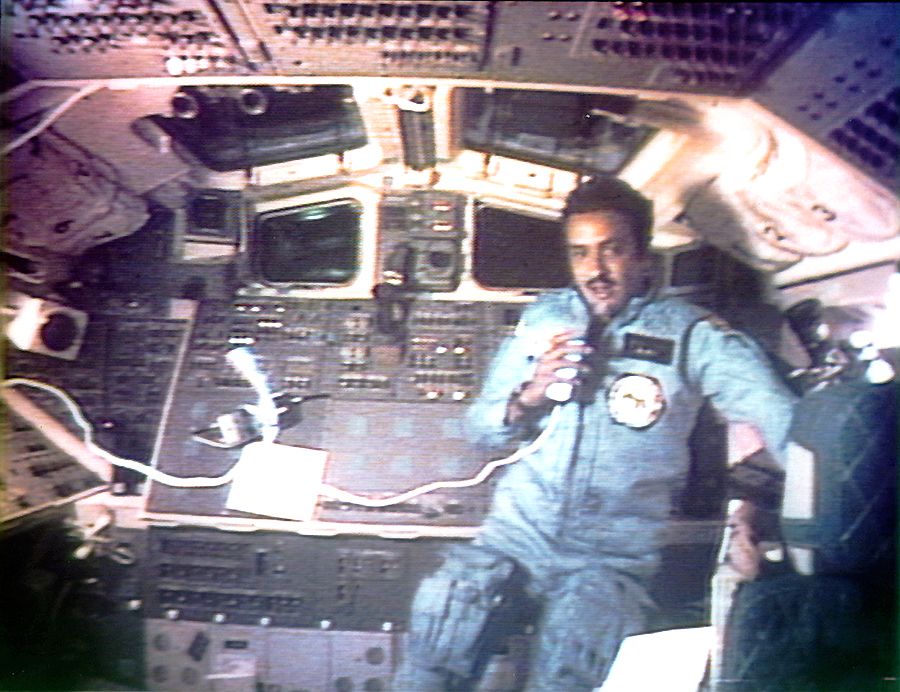
Making contact aboard the shuttle.
She would not wait for long. At 4 a.m. on June 24, Houston’s Johnson Space Center woke the astronauts: “Hello, good morning, you’re all preparing to come back, correct?”
That was a reminder for the astronauts to prepare for re-entry nine hours later, a tricky procedure that involves positioning the orbiter and firing up its engines to re-enter the atmosphere at 22 times the speed of sound, until the shuttle can glide safely back to Earth.
After passing over the Pacific Ocean, Discovery touched down on runway 23 at Edwards Air Force Base at 6.11 a.m. — a flawless landing during a California sunrise.
Watch the landing of Discovery.
“We completed our mission safely. Our mission was actually flawless, Alhamdulillah,” Prince Sultan said.

A tuna break in space.
A tuna break in space.

With the sun rising 16 times a day in space, the astronauts used eye masks to sleep.
With the sun rising 16 times a day in space, the astronauts used eye masks to sleep.

Hello, Discovery: King Salman, with the late King Fahd, speaks to his son in space.
King Salman, with the late King Fahd, speaks to his son in space.

Making contact aboard the space shuttle.
Making contact aboard the shuttle.
Back on Earth
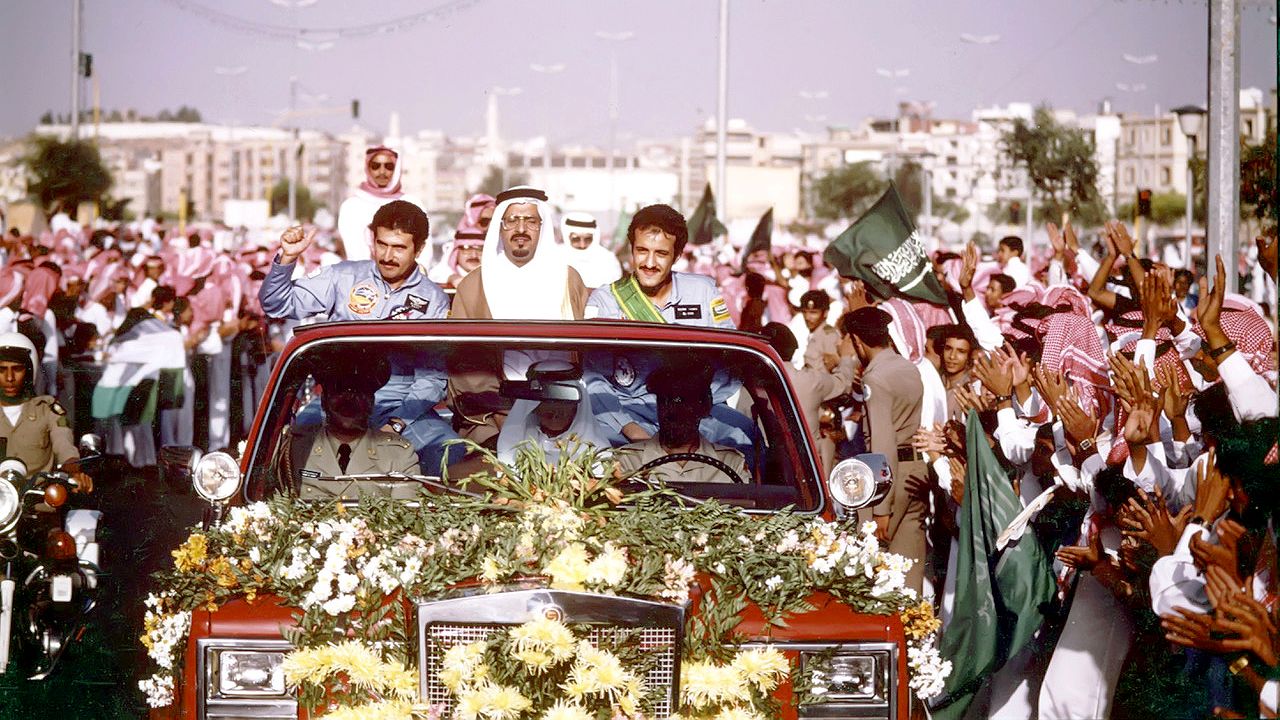
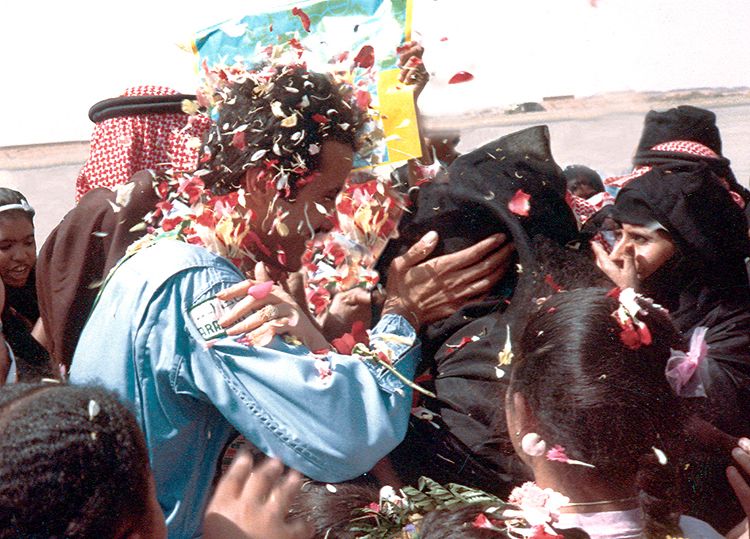
In Taif, Prince Sultan greets his mother, Princess Sultana, in a shower of rose petals.
Greeting his mother, Princess Sultana, in a shower of rose petals.
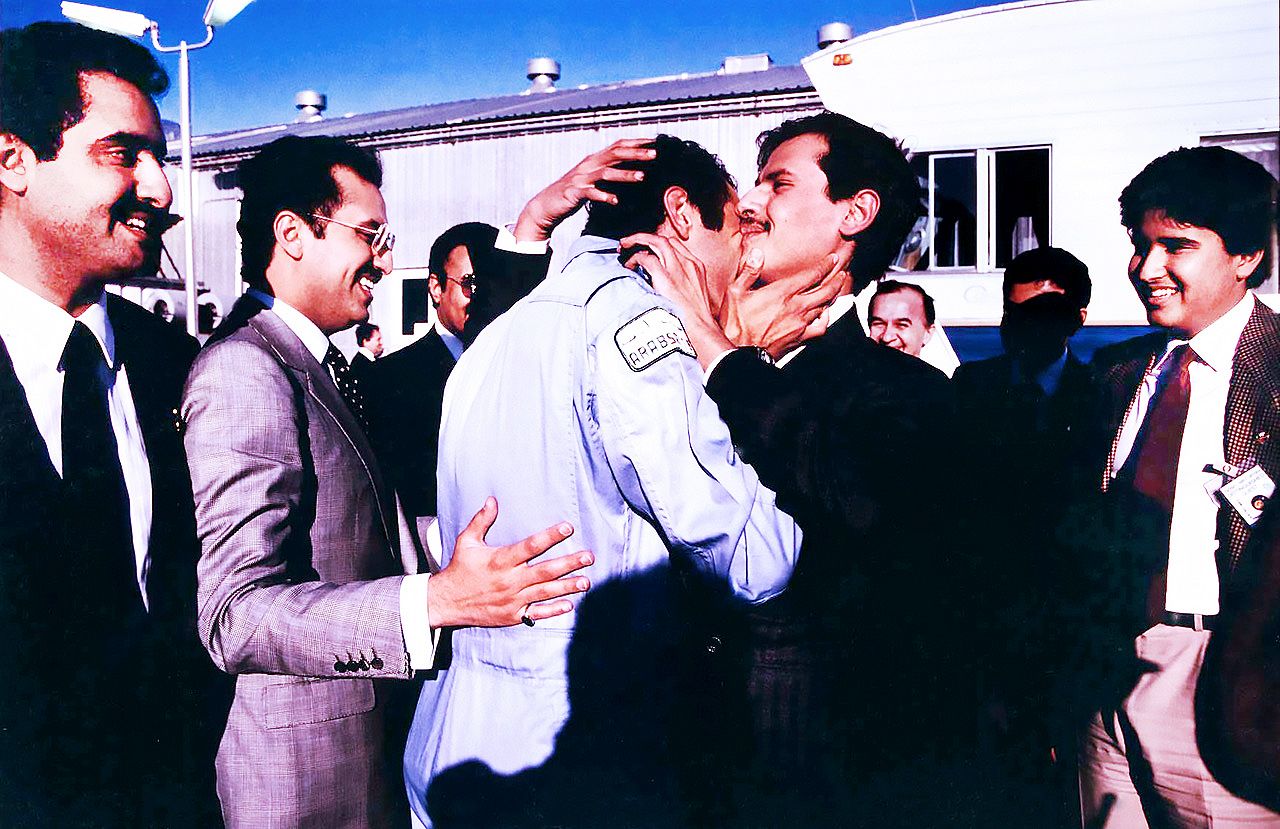
Arriving in California, Prince Sultan embraces his brother Prince Abdul Aziz, surrounded by his other brothers, from left, Prince Ahmed, Prince Fahd and Prince Faisal.
Prince Sultan embraces his brother Prince Abdul Aziz, surrounded by his other brothers.
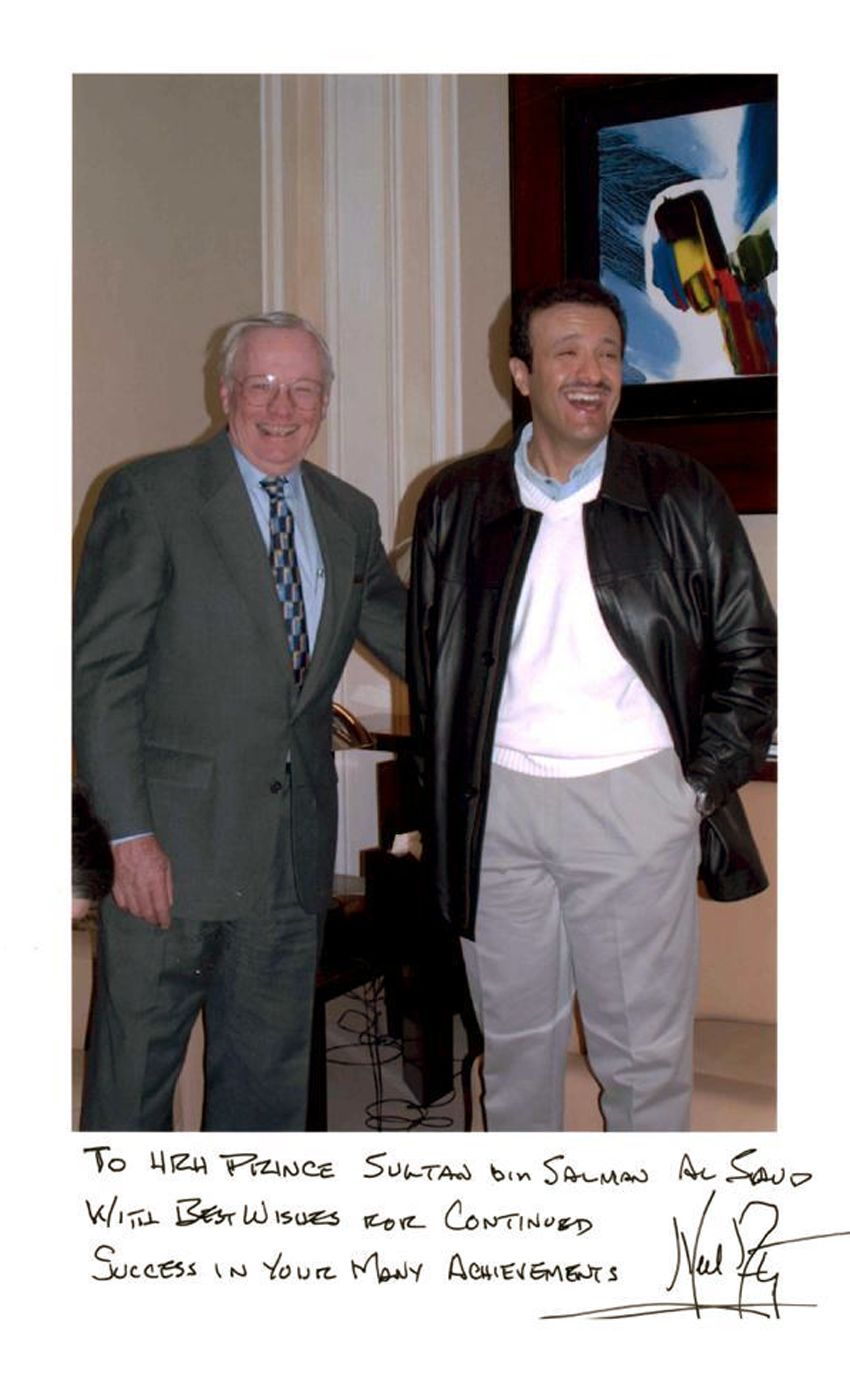
Prince Sultan with Neil Armstrong, the first man to walk on the moon, in Geneva in 2001.
Prince Sultan with Neil Armstrong.
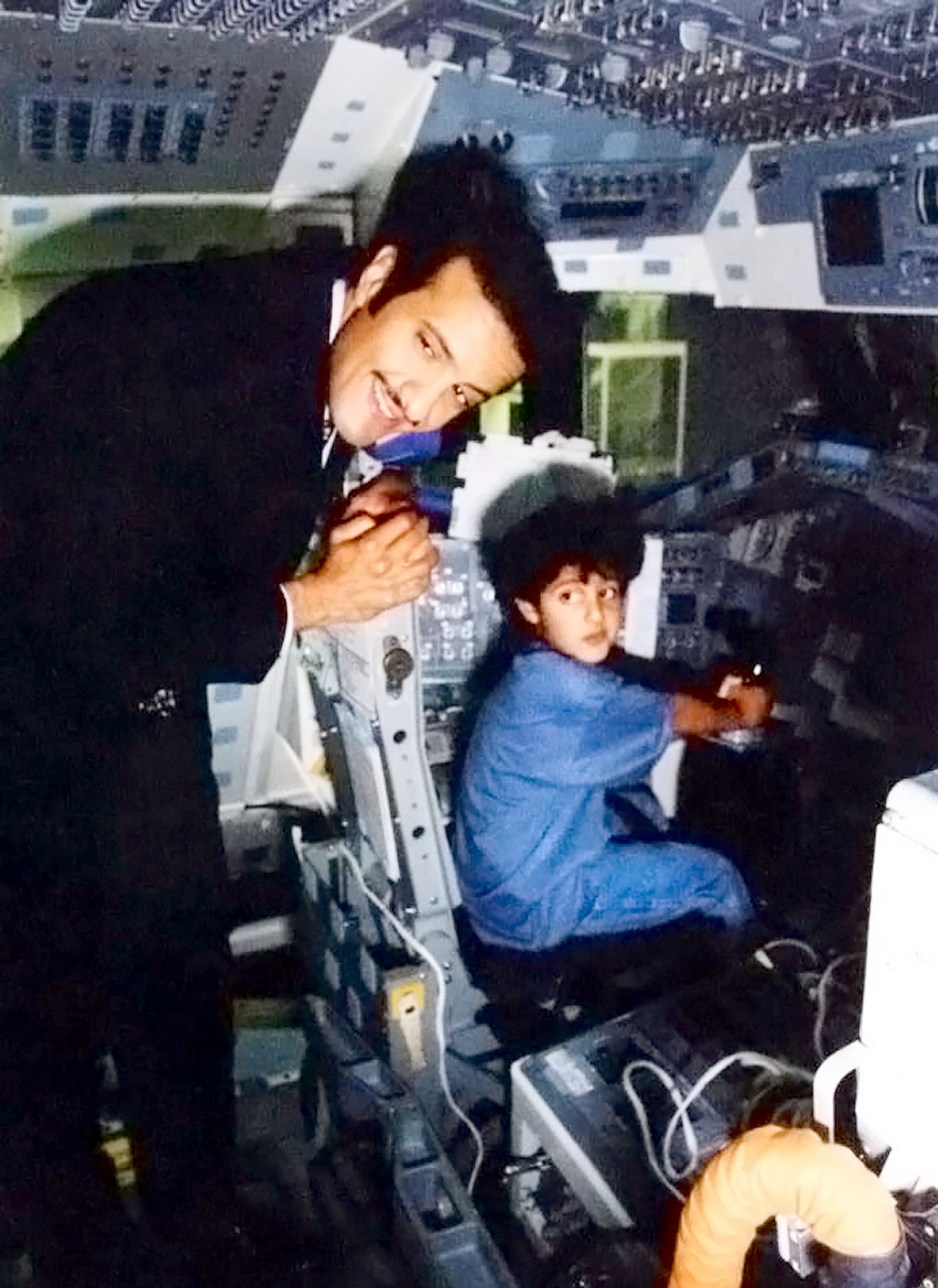
With his son, Prince Salman, at the Johnson Space Center in Houston on the 10th anniversary of his mission in 1995.
With his son, Prince Salman, in Houston on the 10th anniversary of his mission in 1995.
Prince Sultan’s new missions

Greeting his mother, Princess Sultana, in a shower of rose petals.
When the astronauts disembarked in California, Prince Sultan was welcomed back by his brothers, Prince Bandar, Al-Bassam and Dr. Al-Mashat of Arabsat. After a medical exam, the prince flew back to the Johnson Space Center in Houston.
More love was bestowed on him and his team when he returned to Saudi Arabia. Arriving dressed in his spacesuit at the airport in Taif, he was greeted by crowds of Saudis who showered him with rose petals as he was greeted by King Fahd, his father and mother, his sister and many of his uncles.
Upon his arrival in Taif, Prince Sultan was appointed a major in the Saudi Air Force. The pilot-turned-astronaut also became an unofficial ambassador, as many honored him with medals of achievement commemorating his journey. He met with many world leaders, including Ronald Reagan, Jordan’s King Hussein, Pakistani leader Muhammad Zia-ul-Haq, Singapore’s first prime minister Lee Kuan Yew, Palestinian President Yasser Arafat and UAE President Sheikh Zayed.
He also met the astronauts from the Apollo 11 mission, including Michael Collins, Buzz Aldrin and Neil Armstrong. “When I met (Armstrong) I had a really nice conversation with him. He spoke about his upcoming book, spoke about the moon vision,” Prince Sultan recalled. “I also became close to Buzz Aldrin, the second man on the moon.”
Prince Sultan returned from space with a better appreciation of his own blessings, growing up in a caring household and being born a Muslim. He points out that the five pillars of Islam extend to far more than praying five times a day, and that while some people may do so diligently, this is not enough. “You can pray while you’re doing something good, and I tell them: ‘There is a world out there that needs your help and that needs you to be part of it.’”
Seeing Earth from space gave him a broader perspective. “It takes you to the next dimension,” he says. “Your care and your passion for things become more global, more universal.”
In that sense, Prince Sultan was well prepared for his next mission. He was appointed secretary general of the Saudi Commission for Tourism and National Heritage in 2000, and began work to preserve the treasures of the Kingdom. “Finally, people believed that our heritage and culture are not just important but are critical to our future, totally critical,” he said. “Every other civilized country has believed that.”
Rising to president and chairman, and then with the rank of minister in 2009, Prince Sultan oversaw the master plan that would secure the heritage of his country, including having five important areas designated UNESCO World Heritage Sites, beginning with Al-Ula’s Madain Saleh in 2008 and ending with Al-Ahsa Oasis in 2018.
With this important mission accomplished, it was fitting that the prince would come full circle, being appointed as chairman to another newly formed government body in December 2018 — the Saudi Space Commission.
“When I was told to move to this, to create this new commission, it just gave me a pause that my life has always been, for some reason, startups, always for some reason to take a challenge and to do it to the next level.”
The space commission is still in its early days, but Prince Sultan brought with him a team from the tourism commission to begin work on the new project. He gave the ones he left behind an inspiring farewell: “Working for your country and its people gives more years to your life. I will not miss you, for I will see you. We are proud that this commission sprouted from our country with its citizens working hard for it. As for myself, I’m returning to my rightful spot.”

With his son, Prince Salman, in Houston on the 10th anniversary of his mission in 1995.
His rightful spot, indeed. As the country’s first astronaut, he is now looking to build a new generation of Saudi astronauts, whose work will benefit not only the country but also the whole world. “This country has been built for so many generations, and each generation paves the way for the next generation, and creates the platform for the next generation to take it to the next level.”
But remembering the hard work it took to get into space, the prince makes clear that there will be no free rides. “When I look at the next generation that is going to go to space, they’re going to have to be a 360 kind of generation of men and women who will embrace their country. They know why they’re going to space. It’s not a personal junket.”

Prince Sultan with Neil Armstrong.
He reveals some of the Saudi Space Commission’s current activities, which include a master plan, recruitment and talks with stakeholders. “We’ll be announcing the formation of the board of directors with the commission, the International Advisory Board. These are star names; some have flown to space, and others have done big things in space. Those are the people that will actually advise us on everything we’re doing.”
The commission will also have a youth advisory board, as Prince Sultan sees the value in bringing generations together. “This generation can see more clearly their place in the universe. They’re more of a universal generation. But you don’t dismiss the generations before that have done these big things in this country. Unifying this country was the biggest mission of all. Keeping it safe, stable and unified is a mission for all of us.”

Prince Sultan embraces his brother Prince Abdul Aziz, surrounded by his other brothers.
Recently, the prince has taken some exploratory trips, including to Russia in April 2019, where he met with officials at the Russian space agency, Roscosmos, to discuss areas of cooperation and potential investments in the space sector. He is also working at developing a generations program to inspire future Saudi astronauts. “There’s going to be something that kids can relate to, people can interact with … and it will emanate from our own culture.”
Asked if he would venture into space again, this most humble prince cannot resist: “Now that I think about it, if you send me today, you know, I’m healthy, Alhamdulillah. I’m not saying you should send me today, but I’ll take a mission if one comes.”
Prince Sultan speaks about the way forward for the Saudi Space Commission and what the next Saudi astronauts will need.
Prince Sultan speaks about the way forward for the Saudi Space Commission and what the next Saudi astronauts will need.
Arab News Mission Control
Editor: Mo Gannon
Global creative director: Simon Khalil
Reporter: Noor Osama Nugali
Graphics: Douglas Okasaki
Cameraman: Mohammed Al Baigan
Videos: Ali Noori
Photo research: Steve Willard
Photo credits: Saudi Space Commission, NASA
Copy editor: Les Webb
Editor-in-Chief: Faisal J. Abbas
With special thanks to Prince Sultan bin Salman
and Abdulrahman bin Shalhoub at the Saudi Space Commission
